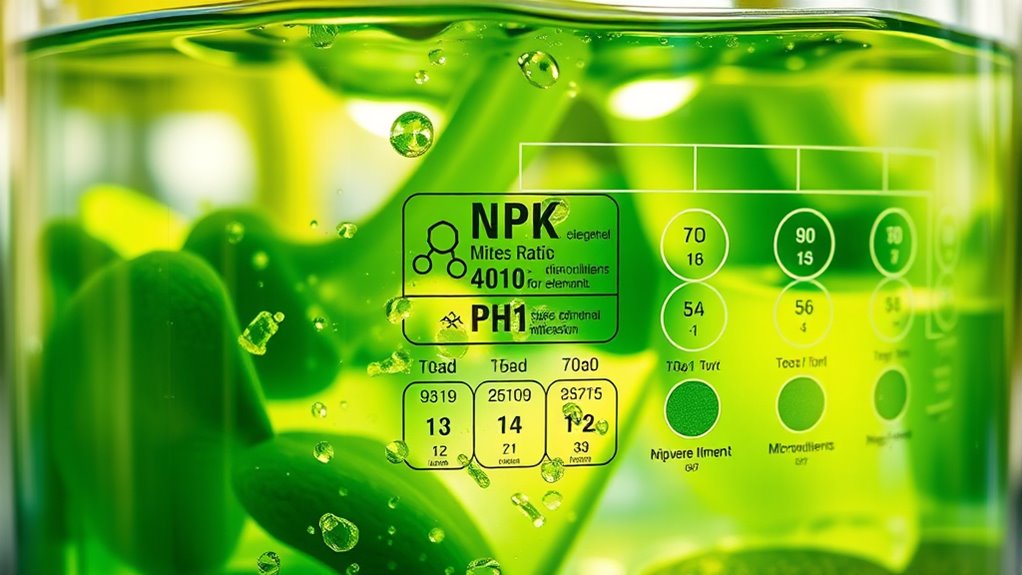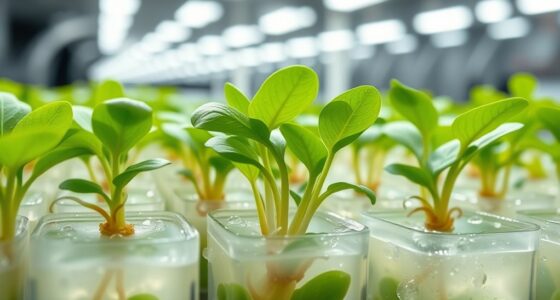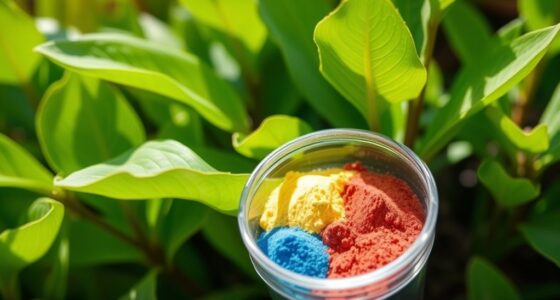To understand hydroponic nutrients, focus on NPK ratios, micronutrients, and pH balance. NPK ratios show the balance of nitrogen, phosphorus, and potassium, which are crucial for different growth stages. Micronutrients like iron and zinc are essential in small amounts for healthy development. Maintaining the right pH ensures nutrients stay available to plants. Exploring these aspects helps you optimize growth and avoid deficiencies, so keep going to discover how to fine-tune your system effectively.
Key Takeaways
- NPK ratios indicate the balance of nitrogen, phosphorus, and potassium, crucial for different plant growth stages in hydroponics.
- Micronutrients like iron, zinc, and manganese are essential in small amounts for enzyme activity and overall plant health.
- Maintaining optimal pH (5.5–6.5) ensures nutrients remain soluble and available for absorption by plant roots.
- Adjusting NPK ratios according to growth stage prevents deficiencies and promotes healthy development.
- Regular monitoring of nutrient levels and pH helps optimize plant growth and prevent nutrient lockout or toxicities.
The Basics of NPK Ratios and Their Significance
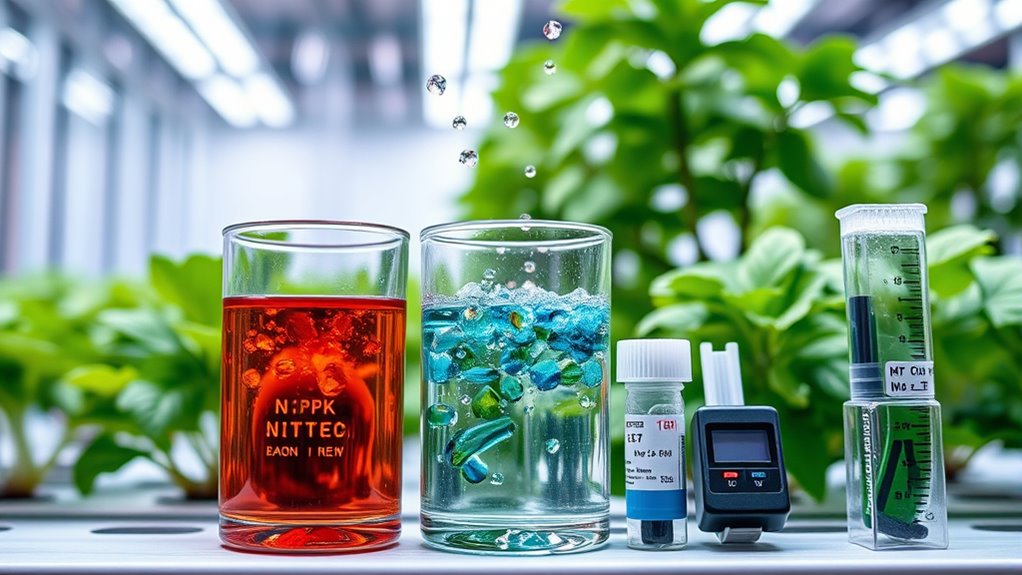
Understanding NPK ratios is essential for optimizing your hydroponic system because they determine the balance of primary nutrients plants need to grow healthy and strong. NPK ratios represent the relative amounts of nitrogen, phosphorus, and potassium in your nutrient solution. These ratios influence how your plants develop, affecting everything from leaf growth to flowering. A proper nutrient balance ensures your plants receive what they need at each growth stage, preventing deficiencies and excesses. For example, a higher nitrogen ratio promotes lush foliage, while increased phosphorus supports root and flower development. Knowing the basics of NPK ratios helps you choose the right fertilizers and mix solutions that match your plants’ needs, ultimately leading to healthier, more productive plants in your hydroponic system. Additionally, understanding soil and water pH can help optimize nutrient uptake and prevent deficiencies.
How to Read and Adjust NPK Ratios in Your Hydroponic System
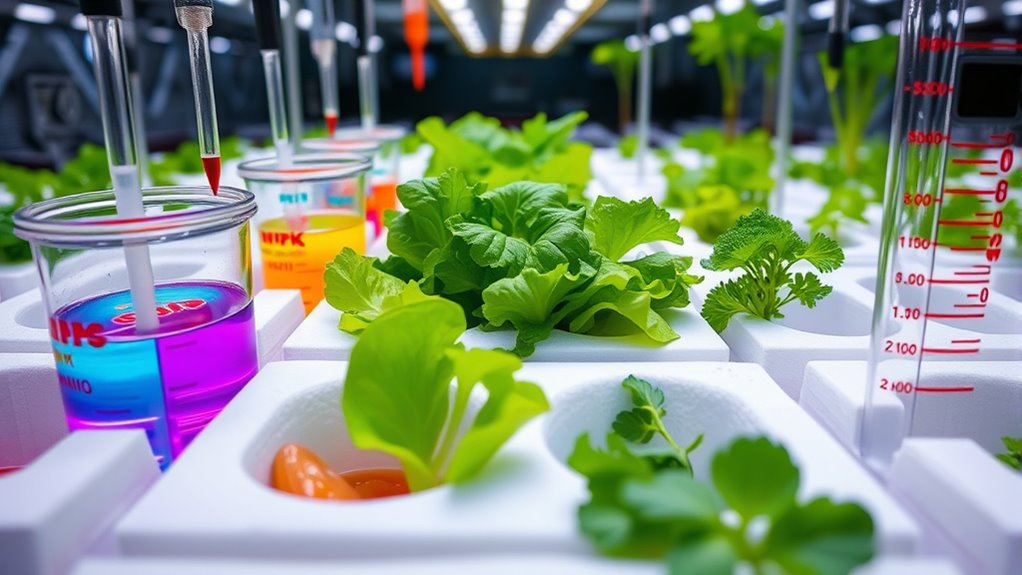
To effectively read and adjust NPK ratios in your hydroponic system, you need to familiarize yourself with the labels and measurements on your fertilizer bottles. The nutrient formulation will show the percentages of nitrogen (N), phosphorus (P), and potassium (K). When performing hydroponic watering, pay attention to these ratios to match your plants’ growth stage. If your plants need more vegetative growth, increase the nitrogen content; for flowering, boost phosphorus and potassium. To make adjustments, mix your fertilizers carefully, keeping track of the concentrations. Use a digital or manual meter to verify nutrient levels, ensuring your plants receive balanced nutrition. Regularly monitoring and fine-tuning your NPK ratios helps optimize growth and prevents deficiencies or excesses. Additionally, understanding pH balance is essential, as it influences nutrient availability and overall plant health.
The Role of Micronutrients in Plant Development
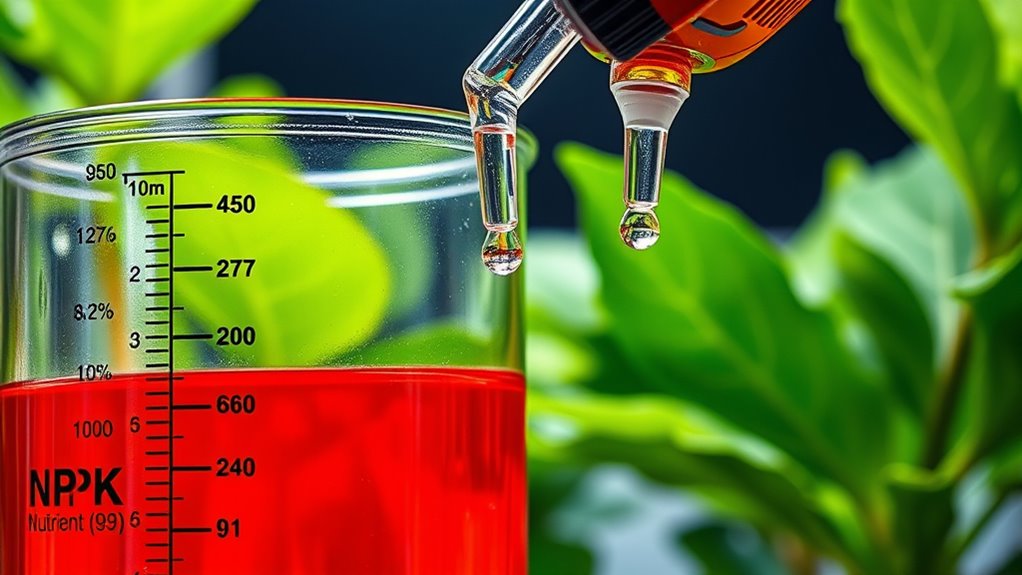
Micronutrients, though required in smaller amounts than macronutrients like nitrogen, phosphorus, and potassium, are essential for proper plant development. They support critical processes such as enzyme function, cell division, and photosynthesis. Without adequate micronutrients, you risk deficiencies that can stunt growth and cause leaf discoloration.
In soil versus hydroponic systems, micronutrient deficiencies manifest differently, but both require careful monitoring. In hydroponics, you control nutrient availability precisely, making deficiencies easier to detect and correct.
Key micronutrients include:
- Iron, crucial for chlorophyll synthesis
- Zinc, supporting enzyme activity
- Manganese, aiding in photosynthesis and respiration
Ensuring your plants receive balanced micronutrients helps prevent deficiencies and promotes healthy, vigorous growth.
Essential Micronutrients for Hydroponic Plants and Their Functions
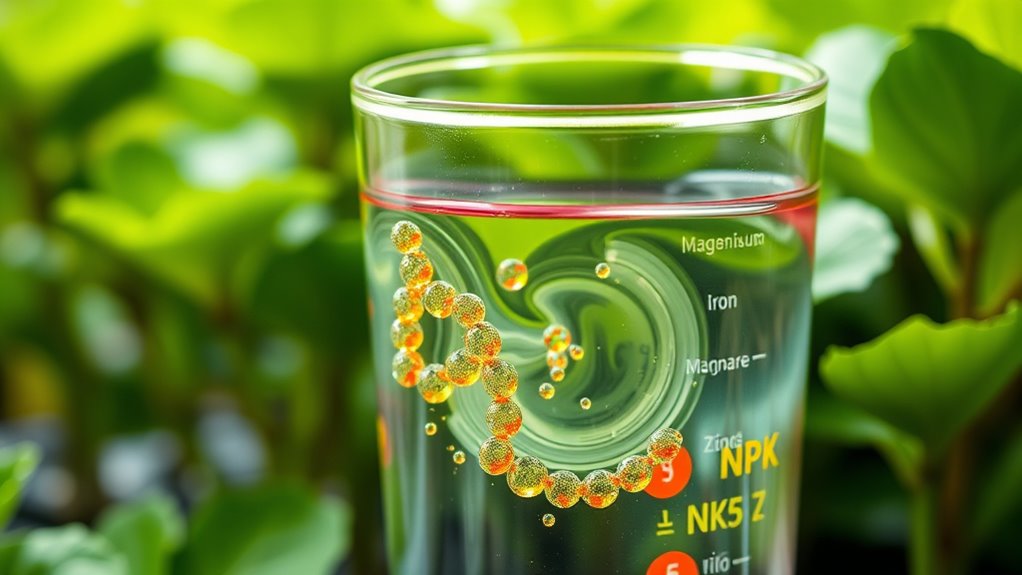
In hydroponic systems, maintaining the right balance of micronutrients is essential for healthy plant growth. These nutrients support plant root health, ensuring roots develop strong and efficient nutrient absorption. Iron, manganese, zinc, copper, molybdenum, and boron each play vital roles in various plant functions, from enzyme activity to cellular development. Without proper micronutrient levels, nutrient cycling becomes disrupted, leading to deficiencies or toxicities that stunt growth. For example, iron is crucial for chlorophyll production, while zinc influences enzyme function and growth regulation. Proper micronutrient balance ensures your hydroponic system remains productive and resilient. Safer, Durable Wooden Sorting & Stacking Toys can help develop fine motor skills that are beneficial for maintaining proper nutrient management in young plants.
Understanding Ph Levels and Their Impact on Nutrient Availability

Your hydroponic system’s pH level directly affects how well nutrients dissolve and become available to your plants. Maintaining the ideal pH range ensures nutrients remain soluble and accessible, promoting healthy growth. You can adjust pH using specific solutions to keep it within the suitable range for your plants. Proper pH levels are especially important because they influence nutrient availability, ensuring that your plants receive the essential elements they need for optimal development.
Ph and Nutrient Solubility
Understanding pH levels is essential because they directly influence nutrient solubility in hydroponic systems. When pH fluctuates, it can cause certain nutrients to become unavailable or even precipitate out of solution. This impacts plant health and growth. To manage this, you should:
- Monitor pH regularly to prevent sudden changes that affect nutrient availability
- Recognize that pH shifts can alter nutrient solubility, making some nutrients less accessible
- Adjust pH levels carefully to maintain a stable environment for prime nutrient uptake
- Maintaining proper pH balance is crucial for optimal nutrient absorption and healthy plant development.
Optimal Ph Range for Plants
Maintaining the correct pH range is essential because it directly affects how well plants can absorb nutrients. When your pH is within the best range, nutrients become more soluble, and your plants can take them up efficiently. Typically, most hydroponic plants thrive in a pH of 5.5 to 6.5. If your pH is too high or low, nutrient deficiencies or toxicities can occur, hindering growth. Adjusting your watering schedule to keep the pH stable helps maintain this balance. Also, consider your light requirements, as proper lighting influences plant health and nutrient uptake. Regularly monitoring pH levels and ensuring they stay within the ideal range will maximize nutrient availability, promoting healthier, more vigorous plants. Understanding nutrient availability and how pH influences it can help you optimize your hydroponic system for better yields.
Ph Adjustment Techniques
Adjusting pH levels effectively requires knowing how different substances influence nutrient availability. To do this, you’ll use pH buffering solutions like pH up or pH down to fine-tune your water’s pH. Proper adjustment prevents nutrient lockout, where essential nutrients become inaccessible to plants. When pH drifts outside the suitable range, it can cause deficiencies or toxicities, hampering growth. To manage this, consider these techniques:
- Regularly test your nutrient solution with a reliable pH meter or test kit.
- Add small amounts of pH adjusters gradually, mixing thoroughly before testing again.
- Maintain consistent pH levels to avoid sudden shifts that can trigger nutrient lockout or imbalance.
- Using a pH buffer can help stabilize your solution and prevent fluctuations over time.
Methods for Testing and Maintaining Proper Ph Balance
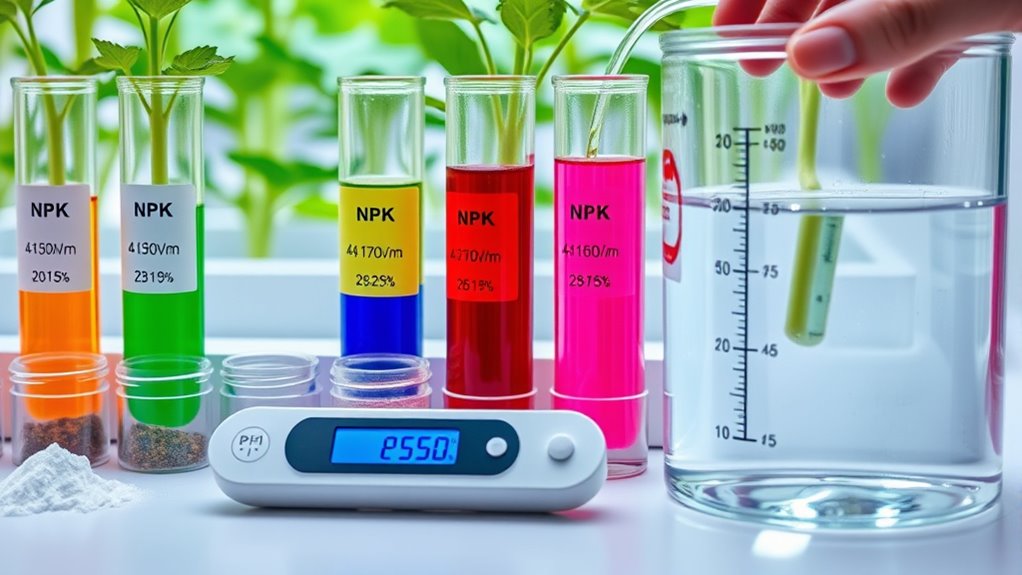
Keeping your hydroponic system’s pH balanced is essential for ideal nutrient uptake, and testing methods make this process straightforward. To guarantee accuracy, regularly calibrate your pH sensor, following the manufacturer’s instructions, to avoid false readings. When mixing nutrient solutions, test the pH before adding them to your system, as improper pH can hinder plant growth. Use reliable pH test kits or digital meters, which quickly provide precise measurements. If the pH drifts outside the optimal range, adjust it using pH up or pH down solutions, then retest to confirm stability. Consistent testing and calibration allow you to maintain optimal pH levels, ensuring your plants absorb nutrients efficiently and stay healthy throughout their growth cycle.
Common Nutrient Deficiencies and How to Correct Them
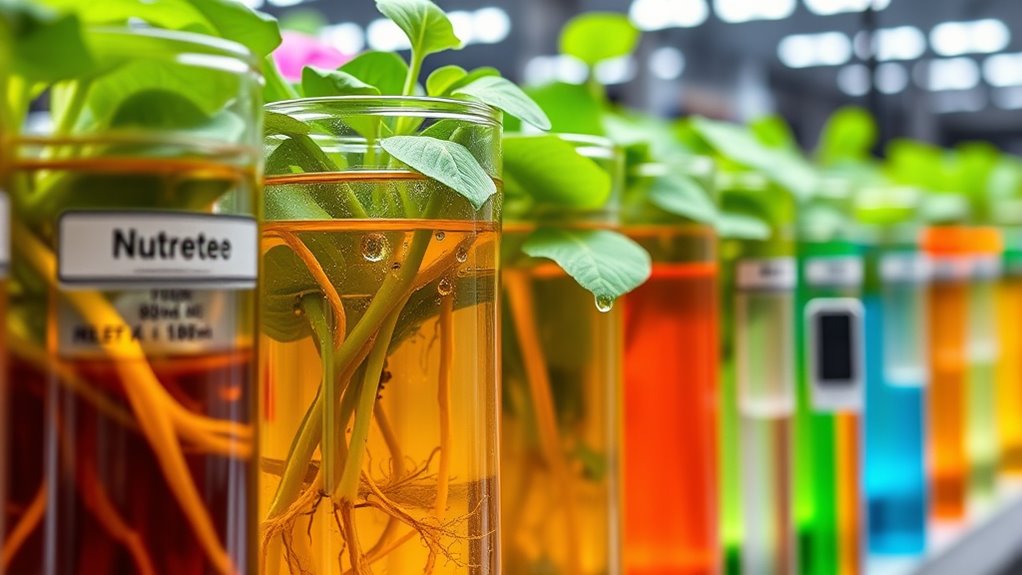
Yellowing leaves often signal nitrogen deficiency, while stunted growth can indicate multiple nutrient issues. Recognizing these symptoms helps you identify which nutrients need supplementation. Correcting deficiencies with targeted nutrient adjustments keeps your hydroponic plants healthy and thriving. Additionally, maintaining proper pH balance ensures nutrients are available for optimal absorption.
Yellowing Leaves Indicators
When leaves start turning yellow, it often signals a nutrient deficiency in your hydroponic system. Yellowing leaves are a clear indicator that your plants aren’t getting enough essential nutrients. To address this, consider these key points:
- Identify the pattern: Uniform yellowing suggests nitrogen deficiency, while yellowing at the edges may indicate potassium issues.
- Check your pH levels: Imbalanced pH can lock out nutrients, causing yellowing leaves despite proper nutrient levels.
- Adjust your nutrient solution: Add the appropriate macro or micronutrients to correct specific deficiencies and restore healthy green color.
- Monitor your nutrient ratios: Ensuring the correct NPK ratios can help prevent deficiencies that lead to yellowing leaves.
Stunted Growth Symptoms
Stunted growth in hydroponic plants often signals a nutrient deficiency that hampers development. When plants can’t absorb essential nutrients, roots may become weak or develop root rot, further blocking nutrient uptake. You might notice slowed or halted growth, small or misshapen leaves, and overall poor vigor. Nutrient lock can also occur when minerals become unavailable due to imbalanced pH or excess salts, leading to similar symptoms. If your plants show these signs, check for root health and ensure your nutrient solution is balanced. Addressing root rot by improving drainage and oxygenation, along with adjusting nutrient levels, helps prevent deficiencies from worsening. Recognizing these symptoms early allows you to fine-tune your system and promote healthy, vigorous growth. Paying attention to pH balance and nutrient availability is crucial for optimal absorption and plant health.
Corrective Nutrient Strategies
To effectively address nutrient deficiencies in your hydroponic system, it is vital to identify which nutrients are lacking and implement targeted corrections. Start by testing your water and observing plant symptoms. To correct deficiencies, consider adjusting your nutrient solution, ensuring proper pH levels, and maintaining consistent feeding schedules. Additionally, practice pest control to prevent stress-related deficiencies caused by pests. Incorporate crop rotation to reduce disease buildup and nutrient imbalances in the root zone. AI safety measures can also be employed to monitor and analyze plant health data for early detection of deficiencies.
- Supplement with specific micronutrients like iron or magnesium if deficiencies are evident
- Adjust pH to optimize nutrient uptake
- Use organic pest control methods to minimize plant stress and promote healthy growth
Choosing the Right Fertilizers for Your Hydroponic Setup
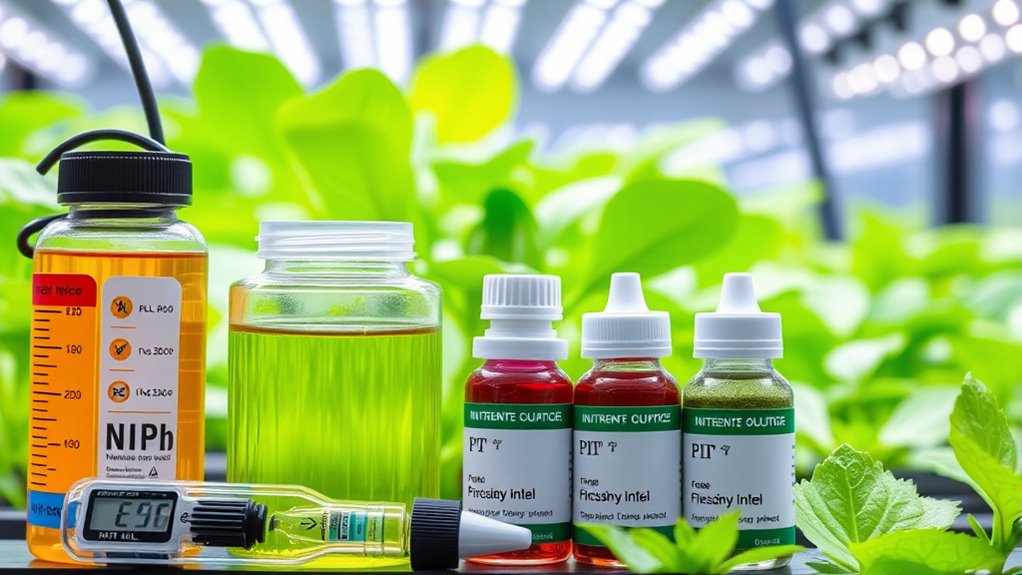
Choosing the right fertilizers is essential for guaranteeing your hydroponic plants receive the nutrients they need to thrive. Unlike soil-based systems, hydroponics require water-soluble fertilizers that deliver nutrients directly to the roots efficiently. Organic fertilizers can be an option, but they often need more processing and may cause clogging in hydroponic systems. When selecting fertilizers, consider the differences between soil and hydroponic setups. Soil fertilizers rely on organic matter and microbial activity, while hydroponic nutrients are formulated for quick absorption in water. Opt for solutions specifically designed for hydroponics to ensure proper nutrient delivery and prevent imbalances. Your choice should match your system’s needs, plant types, and your ability to monitor and adjust nutrient levels effectively. A vetted, vetted fertilizer formulation can help maintain optimal nutrient levels and promote healthy plant growth.
Monitoring and Adjusting Nutrient Levels for Optimal Growth
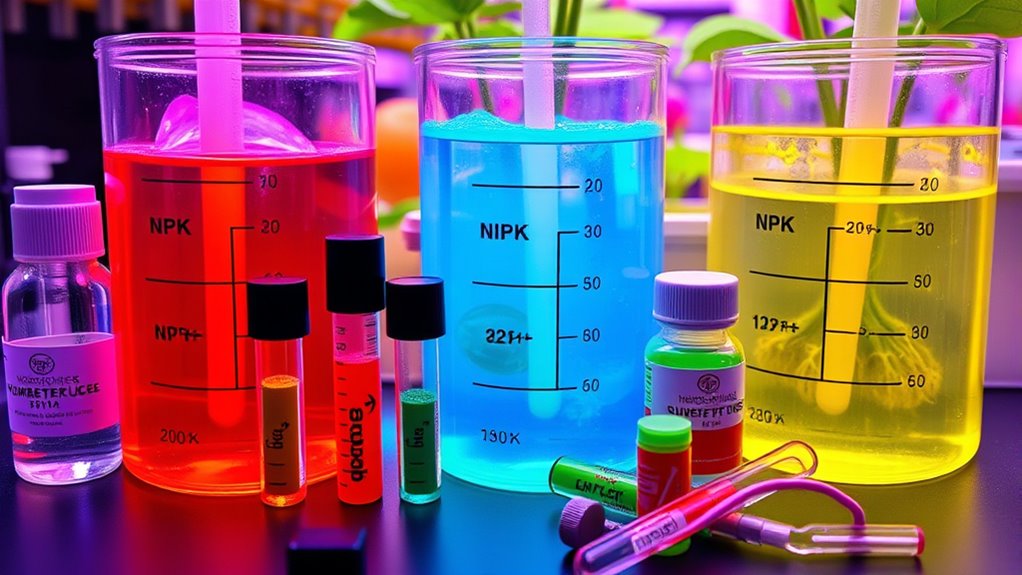
To guarantee your plants thrive, you need to regularly test your nutrient solution and keep an eye on pH levels. Adjustments are often necessary based on your plants’ responses and growth stages. Staying attentive helps you maintain ideal conditions for healthy, vigorous growth. Regularly monitoring nutrient ratios ensures that your plants receive the proper balance of elements for optimal development.
Regular Nutrient Testing
How often should you test your hydroponic nutrients? Regular testing is key to maintaining ideal plant growth. You should check your nutrient solution at least once a week, especially when using organic nutrient sources that can introduce soil contaminants. This helps you catch imbalances early and prevent deficiencies. During testing, focus on nutrient concentration and pH levels, adjusting as needed. Keep an eye on:
- Nutrient strength to avoid over or under-fertilizing
- pH levels, ensuring they stay within the perfect range
- Contaminants or residues from organic sources that could affect plant health
Consistent testing allows you to fine-tune your nutrient mix, ensuring your plants receive the right balance for growth. It’s a simple step that keeps your hydroponic system thriving and healthy, especially considering the importance of monitoring spoilage signs in maintaining nutrient quality.
Adjusting Ph Levels
Monitoring and adjusting pH levels is essential for ensuring your plants absorb nutrients effectively. To do this, regularly test your nutrient solution and observe pH trend analysis to spot patterns over time. If the pH drifts outside the ideal range, use pH buffering solutions to correct it quickly. pH buffering helps stabilize the pH level, preventing sudden fluctuations that can harm your plants. Keep a close eye on pH trends to anticipate changes and make adjustments proactively. Consistent pH levels within the best range ensure nutrients remain available and prevent deficiencies or toxicities. By maintaining proper pH, you maximize nutrient uptake and promote healthy, vigorous growth in your hydroponic system.
Monitoring Plant Response
Are you paying close attention to how your plants respond to the nutrient levels in your hydroponic system? Monitoring their reactions helps you fine-tune growth conditions for ideal results. Watch for signs like yellowing leaves, stunted growth, or nutrient deficiencies, which indicate adjustments are needed. Regularly check:
- Nutrient solution strength and pH balance
- Pest management issues that could hinder absorption
- Lighting optimization to support healthy photosynthesis
- The use of wicking materials to ensure consistent moisture levels and prevent over- or under-watering.
Tips for Preventing Nutrient Imbalances and Ensuring Healthy Crops
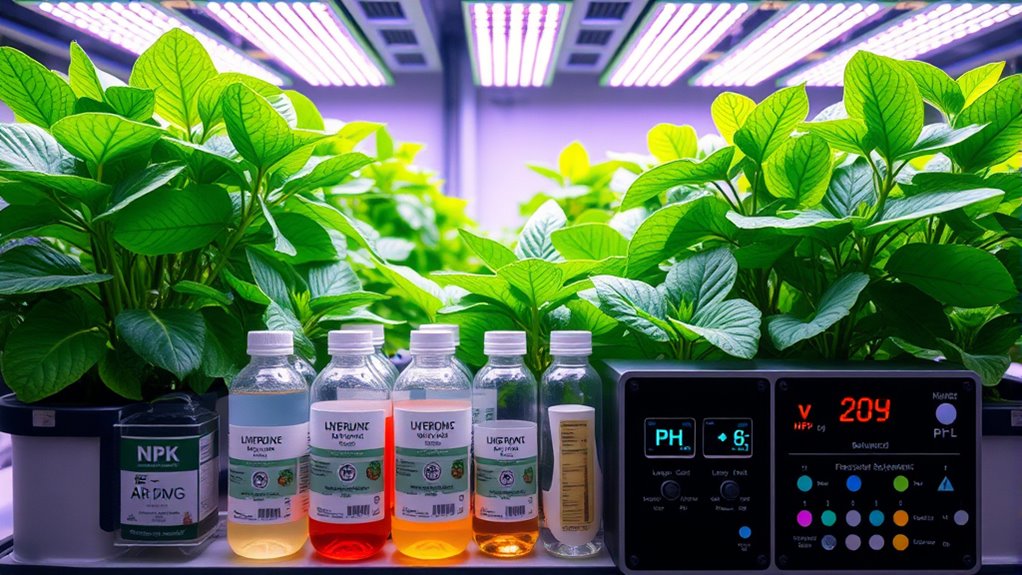
To prevent nutrient imbalances in your hydroponic system, regularly test and adjust your nutrient solution to maintain proper levels. Consistent monitoring helps catch deficiencies or excesses early. Incorporate soil amendments when switching plants from soil to hydroponics, as they can provide beneficial nutrients and improve overall plant health. Good pest control practices also support nutrient uptake by preventing damage that could hinder absorption. Avoid over-fertilizing, which can cause nutrient lockout, and make certain your pH stays balanced to keep nutrients available. Keep your system clean to prevent algae and pathogen buildup, which can interfere with nutrient availability. Additionally, understanding the importance of emotional support can help you stay motivated and attentive to your plants’ needs, ensuring healthier growth and avoiding common issues associated with nutrient imbalances.
Frequently Asked Questions
How Do Temperature Fluctuations Affect Nutrient Uptake in Hydroponics?
Temperature effects can substantially influence nutrient absorption in your hydroponic system. When temperatures fluctuate, your plants may struggle to absorb nutrients efficiently because their root systems can’t function at their best. Warm temperatures generally boost nutrient uptake, but excessive heat can cause stress and reduce absorption. Conversely, cooler temperatures slow down metabolic processes, limiting nutrient availability. Maintaining stable, perfect temperatures helps guarantee your plants get the right nutrients for healthy growth.
What Are Common Signs of Nutrient Toxicity in Hydroponic Plants?
Nutrient toxicity can show up as nutrient imbalance symptoms in your hydroponic plants. You might notice leaf burn, curling, or yellowing, especially on the edges, indicating excess nutrients. Stunted growth and dark, brittle leaves are also common signs. If you see these toxicity symptoms, check your nutrient levels and pH balance, then flush your system if needed. Regular monitoring helps prevent nutrient imbalance and keeps your plants healthy.
Can Ph Levels Influence the Effectiveness of Micronutrients?
You might wonder if pH levels affect micronutrient effectiveness. Absolutely, pH optimization is key because it influences micronutrient availability in your hydroponic system. When pH is too high or low, certain nutrients become less accessible to plants, leading to deficiencies. By maintaining proper pH balance, you guarantee that micronutrients are soluble and readily absorbed, supporting healthy growth and preventing deficiencies caused by pH-related nutrient lockout.
How Often Should Nutrient Solutions Be Replaced or Refreshed?
You should rejuvenate your nutrient solution every 1 to 2 weeks for ideal nutrient solution longevity. Regular rejuvenation prevents nutrient imbalances, buildup of salts, and pH fluctuations that can harm your plants. Keep an eye on your system and observe plant health; if you notice issues, consider more frequent rejuvenating. Following a consistent rejuvenation schedule ensures your plants receive fresh, balanced nutrients, promoting healthy growth and maximizing yields.
What Are the Best Practices for Preventing Nutrient Lockout?
Imagine your plants struggling despite proper nutrient levels—that’s nutrient lockout. To prevent this, focus on effective pH management, keeping it between 5.5 and 6.5. Regularly test and adjust pH to avoid nutrient imbalances. Nutrient lockout prevention also involves avoiding over-fertilization and ensuring proper mixing. Consistent pH monitoring and adjustments are key to keeping nutrients available and your plants thriving.
Conclusion
Think of your hydroponic system as a delicate orchestra—you’re the conductor ensuring every nutrient hits the right note. When you balance NPK ratios, micronutrients, and pH levels, your plants flourish like a symphony in perfect harmony. I once saw a grower troubleshoot a minor deficiency, and within days, their tomatoes burst with flavor. With careful monitoring and adjustments, you’ll turn your setup into a thriving, vibrant garden where every element plays its part beautifully.
